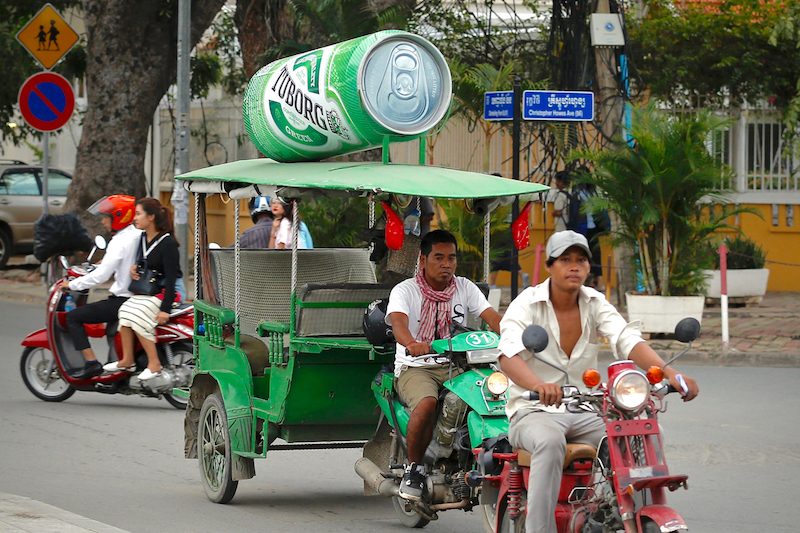Chhay Chanpisal sees three or four alcohol advertisements daily, but the Preah Sisowath High School senior doesn’t think such ads influence his own drinking.
“It depends on how I’m feeling, not on the advertisements,” the 18-year-old said on Monday, flanked by two friends at the Phnom Penh school’s campus.

And yet, a few weeks ago, he started noticing television ads for Tuborg, a Danish beer that entered the Cambodian market in August with a massive sales campaign: TV spots, cinema trailers, Facebook ads and giant cans mounted on top of green tuk-tuks.
He was intrigued. The young people in the commercials looked to be in their late 20s, and were attractive and having a lot of fun, Mr. Chanpisal said.
“They looked good,” he said. “It’s new and I wanted to try it.”
With no minimum drinking age and widespread, mostly unregulated alcohol advertising on TV, billboards, social media and tuk-tuks, booze is readily available and enticing to Cambodian teenagers.
And according to a recent study on alcohol consumption, self-reported exposure to advertising is correlated to teen alcohol use and drunkenness. The survey’s results show a clear association between ads and drinking, said Chher Tepirou, one of the study’s authors.
“In this society, nowadays, some teenagers are much influenced by [their] surrounding environment, therefore they…follow their friends’ lifestyle or advertising,” Ms. Tepirou, a dentist who heads the oral health bureau at the Ministry of Health’s preventive medicine department, said in an email last week. “Some never think about the long-term impact of their actions at present to their future health.”
More than half of the 3,806 students surveyed reported seeing alcohol advertisements on a daily or nearly daily basis. Twelve percent of this group said they consumed alcohol in the past month and nearly 13 percent said they’ve been “really drunk” at least once in their lives. The figures compare to 10 and 11 percent, respectively, for all respondents, and 8 and 7 percent for the fifth of students who said they never or rarely saw alcohol ads.
Ang Ven Mouy, another Preah Sisowath senior, said she doesn’t drink, but considered most ads hawking beer and liquor to be sending a clear message to teens.
“It looks cool and allows you to make friends,” Ms. Ven Mouy, 18, said. “It makes them feel happy and they try it.”
Popular Cambodian beer brands, including Cambodia and Angkor, also have widespread promotional campaigns.
In a bid to regulate the market and address a rise in problem drinking in Cambodia, an alcohol control law has been drafted proposing a minimum drinking age and restrictions on alcohol advertising, among other measures. The draft has been in the hands of the Council of Ministers for about a year.
Previously, in October 2014, the Ministry of Information issued a directive restricting alcohol advertisements on TV and radio during the primetime broadcast slot of 6 to 8 p.m. in an effort to reduce drunk driving fatalities.
But with prominent beer ads on billboards, in Facebook feeds and at streetside restaurants and drinking establishments, banning broadcast ads was not enough, said Mom Kong, the executive director of the Cambodia Movement for Health, who helped draft the alcohol control law in 2013.
“Alcohol advertising is not only on TV,” he said. The ministry directive was also difficult to enforce and lacked teeth, Dr. Kong added. “You cannot fine or put penalties on the violators.”
Asked how the ministry enforced the restrictions on broadcasters, Ouk Kimseng, an undersecretary of state, said he was unaware of any “visible infringement” of the rules.
The majority of Cambodians—96 percent—said they would like the government to adopt an effective measure to reduce the use of alcohol, according to a 2014 report from the Royal University of Phnom Penh and the World Health Organization.
Ninety-five percent said they wanted the government to ban the sale of alcohol to children. More than a quarter of those polled said the alcohol’s brand name influenced which alcohol they purchased, according to the report.
While the alcohol control law is still pending, the Ministry of Information was trying to find a balance between the interests of broadcasters, brewers and society, Mr. Kimseng said.
“At least we can reduce the visibility of the advertisements, especially to children during primetime,” he said.
Mr. Kimseng said the ministry hoped to limit alcohol ads to an extent that would still be acceptable to broadcasters, which rely on alcohol ad revenue.
“That’s why we try to minimize, but not stop, where possible,” Mr. Kimseng added.
Dr. Kong said the people featured in alcohol advertisements, including celebrities, made it obvious who was being targeted. “Is it an old man or is it young people? It’s young people,” he said.
Televised concerts, which are also particularly popular among youth, are usually sponsored by alcohol brands, he said.
Forty percent of Tuborg’s ad budget is being spent on TV and concerts, Kelvin Ng, brand marketing manager at Cambrew, which includes Tuborg among its brands, said in an email on Wednesday.
Tuborg sponsored a “Party of the Year” last weekend on Koh Pich, for example, featuring Cambodian, Thai and South Korean pop stars.
Mr. Ng said Tuborg’s target audience was youth aged 18 to 24 and the company has seen sales growth every month since the campaign launched.
“We are expecting to accelerate the growth when we further activate the brand in the provinces next year,” he said. “The feedback we received from the market is very positive.”
Those among the target demographic don’t always want to fully admit advertising’s effects on them.
“When they advertise like that, teenagers want to drink like that,” said Mr. Chanpisal, the high school student. “It has an impact on teenagers, but not too much.”
(Additional reporting by Chhorn Phearun and Phan Soumy)




